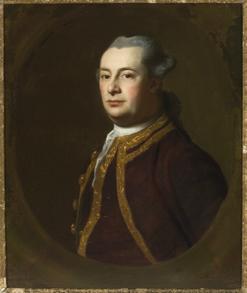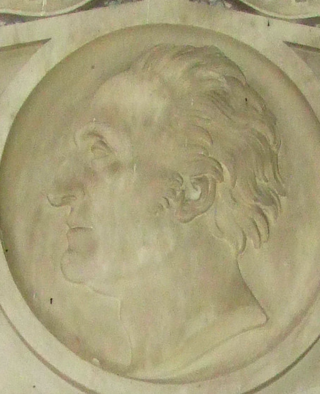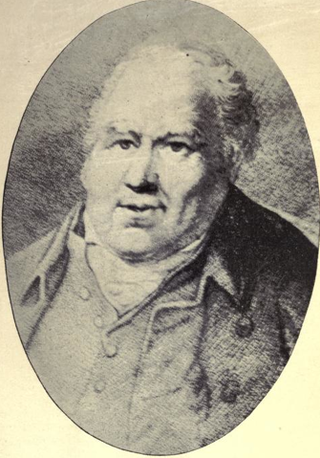
Joseph Frederick Wallet Des Barres was a Canadian cartographer who served in the Seven Years' War, as the aide-de-camp to General James Wolfe.

General George Ramsay, 9th Earl of Dalhousie,, styled Lord Ramsay until 1787, and Baron Dalhousie from 1815, was a Scottish soldier and colonial administrator. He was Governor of Nova Scotia from 1816 to 1820, Governor General of British North America from 1820 to 1828 and later Commander-in-Chief in India. In turn, his son, James Andrew Broun-Ramsay, 1st Marquess of Dalhousie, would later serve as Governor-General of India.

The viceregal consort of Canada is the spouse of the serving governor general of Canada, assisting the viceroy with ceremonial and charitable work, accompanying him or her to official state occasions, and occasionally undertaking philanthropic work of their own. As the host/hostess of the royal and viceroyal residence in Ottawa, the consort, if female, is also known as the chatelaine of Rideau Hall. This individual, who ranks third in the Canadian order of precedence, after the Canadian monarch and the governor general, is addressed as His or Her Excellency while their spouse is in office, and is made ex officio an Extraordinary Companion of the Order of Canada and a Knight or Dame of Justice of the Most Venerable Order of the Hospital of Saint John of Jerusalem.

Michael Francklin or Franklin served as Nova Scotia's Lieutenant Governor from 1766 to 1772. He is buried in the crypt of St. Paul's Church (Halifax).

The office of Commander-in-Chief, North America was a military position of the British Army. Established in 1755 in the early years of the Seven Years' War, holders of the post were generally responsible for land-based military personnel and activities in and around those parts of North America that Great Britain either controlled or contested. The post continued to exist until 1775, when Lieutenant-General Thomas Gage, the last holder of the post, was replaced early in the American War of Independence. The post's responsibilities were then divided: Major-General William Howe became Commander-in-Chief, America, responsible for British troops from West Florida to Newfoundland, and General Guy Carleton became Commander-in-Chief, Quebec, responsible for the defence of the Province of Quebec.

Lieutenant-General Sir John Harvey, was a British Army officer and a lieutenant governor.

Captain Sir Andrew Snape Hamond, 1st Baronet was a British naval officer and Lieutenant Governor of Nova Scotia from 1781 to 1782 and Comptroller of the Navy from 1794 to 1828.
James "Judge" Fulton was a justice of the peace, judge, surveyor, politician, and founder of the village of Bass River, Nova Scotia.

General Richard Philipps was said to have been in the employ of William III as a young man and for his service gained the rank of captain in the British army. He served at the Battle of the Boyne in 1690 and promoted to Lieutenant Colonel in 1712.
Alexander Cosby was born in Ireland and had a younger sister who married Richard Philipps, governor of Nova Scotia and a military man. Through this connection, Cosby was appointed major in the 40th regiment and was stationed in Nova Scotia around 1721. He looked to be appointed lieutenant governor in 1725 but the appointment went to Lawrence Armstrong. Cosby served on the Nova Scotia Council.

Jean-Paul Mascarene was a British Army officer and colonial administrator who served as commander of the 40th Regiment of Foot and governor of Nova Scotia from 1740 to 1749. During this period, he led the colony through King George's War with the French, and rose to the rank of Major-general. He is best known for repulsing two French attempts to capture Annapolis Royal in 1744 and 1745.

George Stracey Smyth was Commander-in-Chief, North America, Lieutenant Governor of Nova Scotia and Lieutenant Governor of New Brunswick.

Sir Brenton Halliburton was the eighth Chief Justice of the Supreme Court of Nova Scotia.

Jonathan Belcher was a British-American lawyer, chief justice, and acting Governor of Nova Scotia during the period of 1760-63 when Henry Ellis was in office as Governor but did not fulfil his duties.

Francis Legge was a British military officer and colonial official in Nova Scotia during the 18th century. He served as governor of Nova Scotia from 1772 to 1776. During the American Revolution, Legge raised the Royal Nova Scotia Volunteer Regiment.

Andrew Belcher was a British North American merchant, politician and justice of the peace from Halifax, Nova Scotia.

Formally known as "His Majesty's Council of Nova Scotia", the Nova Scotia Council (1720–1838) was the original British administrative, legislative and judicial body in Nova Scotia. The Nova Scotia Council was also known as the Annapolis Council and the Halifax Council. After 1749, when the judicial courts were established, the Nova Scotia Council was limited to administrative and legislative powers.
Major Otho Hamilton was a military officer of the 40th Regiment of Foot who served on the Nova Scotia Council and as Governor of Placentia.
Bryan Finucane was an Irish-born lawyer who served as Chief Justice of Nova Scotia from 1778 to 1785.















